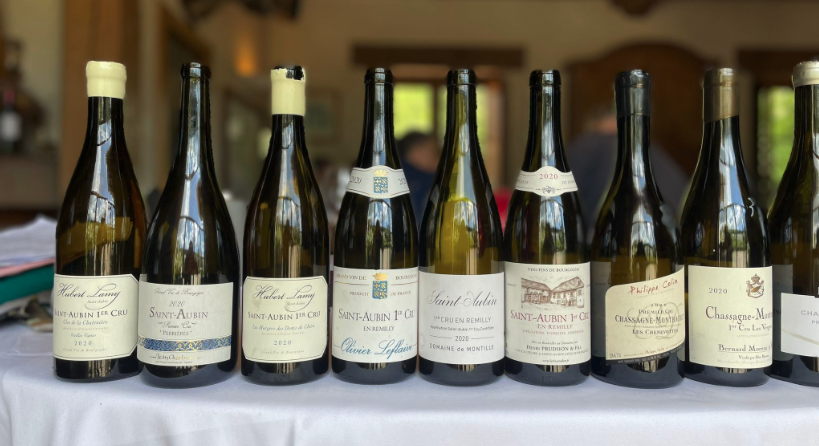

That we were asking ourselves whether 2020 had provided the best ever white Burgfest tells you all you need to know about our opinions of the vintage.
Over five days we blind-tasted our way through 250ish of the vintage’s top wines, all at 1er- and Grand- Cru level. By the end of day two it was clear that 2020 is a very special year for white Burgundy, both in terms of absolute quality and – crucially – consistency. The week saw some very high ratings and one, notoriously conservative (grumpy?), scorer gave his highest ever mark at Burgfest!
In short, 2020 came across as a very classical white Burgundy vintage and, in the era of global warming, classicism is becoming a rare attribute. There will be comparisons with 2017 but, as much as I enjoy 2017s, that vintage is both sweeter and riper with quite a lot of botrytis influence in the wines.
Before Burgfest, 2020 was not a vintage I knew well. Covid had put a spanner in the works of the usual barrel tastings so this was the largest sample and widest survey of the vintage I had yet seen. After Burgfest, I was left wanting a lot more 2020 in my cellar.
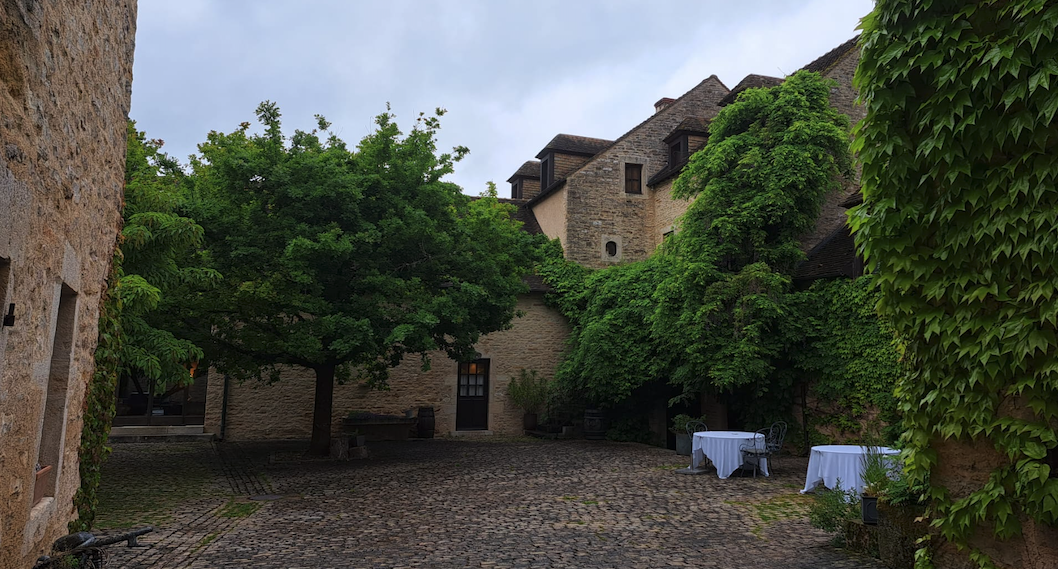
What is the key to the success of 2020 whites?
In a word: acid. Specifically, low pH values.
It is hardly revolutionary to attribute the success of a white wine vintage to acidity. Afterall, acid is a key structural element to all wine, but particularly whites. For a Chardonnay, especially one from Burgundy, to be flabby due to deficient acidity is the height (or depth?) of criticism.
2020 ain’t flabby.
pH is a measure of the intensity of acidity and the lower the pH value, the greater the intensity. For the technically minded, it is a negative logarithmic scale of the concentration of hydrogen ions.
2020 saw a (sometimes very) warm growing season, albeit without the extremes of the hottest years and was remarkably dry after June. Late August saw a heatwave and the conventional wisdom is that this would cause the grapes to drop acidity. Instead, what appears to have happened is that evaporation, aided by a consistent breeze from the north, served to concentrate acidity in the fruit.
Low pH wines tend to give wines a brightness, rendering the fruit more vivid and lending it a ‘high definition’ quality. The intense acidity seems to elevate sensations of minerality, tension and salinity. During the tasting, I found lots of wines with huge reserves of energy and drive and started using words like thrust and acceleration to convey the sense of dynamism.
If all this sounds a bit fanciful, it is simply the opposite of a very ripe vintage obscuring a wine’s detail and vineyard characters behind rich and concentrated fruit. 2020’s high intensity acidity serves to pick out the detail, accent the fruit and create a sense of light and shade in the wines. Moreover, I am not suggesting that low pH wines somehow contain more minerals or salt; rather that our perception of whatever it is that we describe as minerality or salinity in white wine is closely tied up with acidity and therefore emphasised in the 2020s.
Of course, neither acidity nor pH in isolation can deliver quality; there must be balance. The warm, dry summer and August heatwave seems to have ripened the fruit to balance the backbone of acidity. Early picking – Jean-Michel Chartron begain on 14th August, his earliest harvest ever – saved the fruit from accumulating too much sugar and tipping into over-ripeness, and relatively generous yields seem to have tempered the danger of excessive concentration.

So how good were the 2020s at Burgfest?
If the suggestion that this was the best white Burgfest ever is correct, that would put 2020 ahead of the 2014 vintage. I first joined this group for the 2015s so missed the 2014 session, but that vintage remains the benchmark for me and I am not quite ready to make the call that 2020 is better.
However, there is no doubt that 2014 has some issues and its share of premature oxidation problems. One of 2020’s great strengths is consistency and, with the massively increased use of Diam closures, the threat of oxidation should be diminished. It is probably wise not to close the door on 2020 over-taking 2014 in time.
My highest scoring wine, rated 98/100, was a Grand Cru from Chevalier Montrachet.
2020 Chevalier Montrachet Grand Cru La Cabotte, Domaine Bouchard Pere et Fils
Lots in common with the previous wine [Marc Colin’s Chevalier] but delivering an extra degree of complexity and spice. Reduction is really smart, giving smoke, minerality and complexity. It’s profound in its fruit as well as elevated, aerial and spice-driven.
98/100 – Matthew Hemming MW
Interestingly, I rated the La Cabotte version of Bouchard’s Chevalier two points ahead of the ‘regular’ (although still excellent) version. Below this, I gave six wines 97/100 and eleven 96/100, spread across all the major villages and including ten 1er Cru wines alongside the Grand Cru balance.
Even Chablis – which seemed to have been more impacted by the summer heat than the Cote de Beaune and did not shine so brightly at Burgfest – managed a 96/100. Jean-Paul et Benoit Droin’s Chablis Grand Cru Hommage a Louis is named for Benoit’s great-great-grandfather who made the domaine’s inaugural vintage of Les Clos. For now, the domaine is not allowed to claim Grand Cru Les Clos on the label, as there is a dispute over whether some of the vines fall into neighbouring Valmur. Regardless, it is a sensational example of 2020 Chablis.
2020 Chablis Grand Cru Hommage a Louis, Jean-Paul et Benoit Droin
A total catch-you-out wine. Appears a bit reductive and hard at first. The palate has amazing spice, complexity and volume – but without being broad. Has notes of both oak and wild honey, but they are subtle. Right on the edge but also right on the money! Fantastic spice and verve.
96/100 – Matthew Hemming MW
Two producers really stood out for me in this year’s Burgfest: Domaines Leflaive and Paul Pillot.
Leflaive really seem to have reclaimed their past glories – moving out of the era of premox and into the age of Diam! Across the three wines included in our tasting, this estate got a higher average score than any other and, once again, I would highlight Puligny Montrachet 1er Cru Les Combettes as the sweet spot for quality. With winemaker Pierre Vincent set to leave to focus on his on domaine, it will be interesting to see what happens at Leflaive from next year.
Quite simply, I believe Domaine Paul Pillot is the most exciting white wine producer in Burgundy right now. Thierry Pillot is working absolute magic and is edging ahead of his peers – such as Moreau, Dancer and Bachelet-Monnot – for my money. His Grandes Ruchottes was one of the group’s highest-scoring 1er Crus of the entire Burgfest.
2020 Chassagne Montrachet 1er Cru Grandes Ruchottes, Domaine Paul Pillot
A similar profile to the previous wine [Pillot’s Grande Montagne] but with a more intense and penetrating intensity of scent – fennel, sage and mint. This is seriously driving and focused. Has superb mineral cut and spine. Really lifted and racy on the finish. Magnificent.
95/100 – Matthew Hemming MW
My advice: buy up Paul Pillot on sight; the wines are already popular and are only going to get more expensive and harder to find.
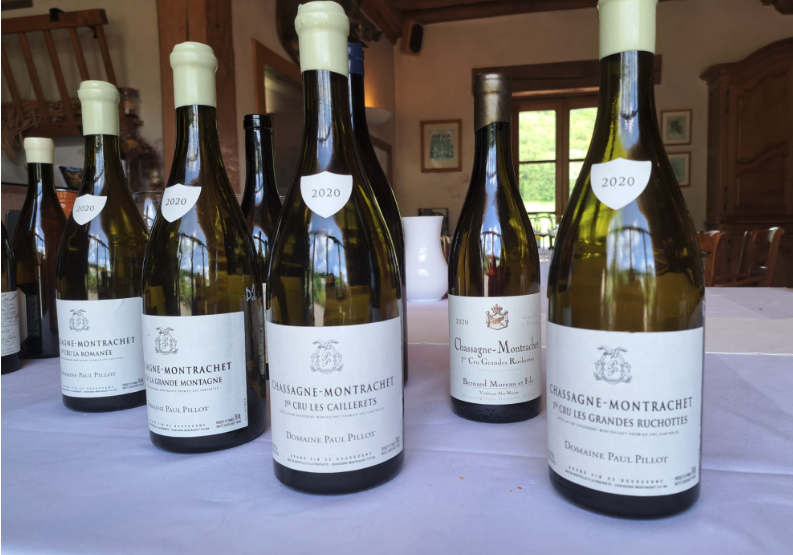
Is 2020 a truly great vintage?
A great vintage is not made by a few outstanding wines, it has to be consistent. An example I often use, borrowing from Bordeaux, is that I would always choose a top 2010 wine over its equivalent from 2009 but I believe 2009 is the better vintage. What I mean is that I prefer the likes of Chateau Latour 2010 over the 2009, but ‘10 is a less consistent year and the average bar of quality is higher in ’09.
2020 is revealing itself to be a year with over-achieving white Burgundies from throughout the region and both up and down the quality hierarchy. It is this consistency that ticks the box for a great vintage – yes, there are outstanding wines in Chevalier Montrachet but there are also 1er Crus that rival Grand Crus, village wines behaving more like 1er Crus, and Bourgognes that deliver more pleasure than one would ever expect.
Interestingly, looking back to last year’s tasting, 2019 seems to have delivered some higher highs, a small number of wines with greater drama and fireworks. In 2019 I had two wines with 99/100 – Marquis de Laguiche Montrachet and Domaine Leflaive Chevalier Montrachet – out-scoring the 98/100 high point of the 2020 tasting. However, in 2019 there were fewer top 90s scores and more in the low 80s. In other words, 2019 lacks 2020’s quality of consistency.
White Burgundy 2019 is a high wire act – hence the drama – but with too many examples toppling from the heights due to over-ripeness, high alcohol and a lack of energy. The vivid acidity and thrust of 2020 delivers much more reliably across the board: it is a more consistent and more successful vintage. Individual 2019s will provide utterly thrilling, compelling drinking but you need to pick extremely carefully. Buying without the opportunity to taste or choosing from a wine list; it needs to be 2020 every time.
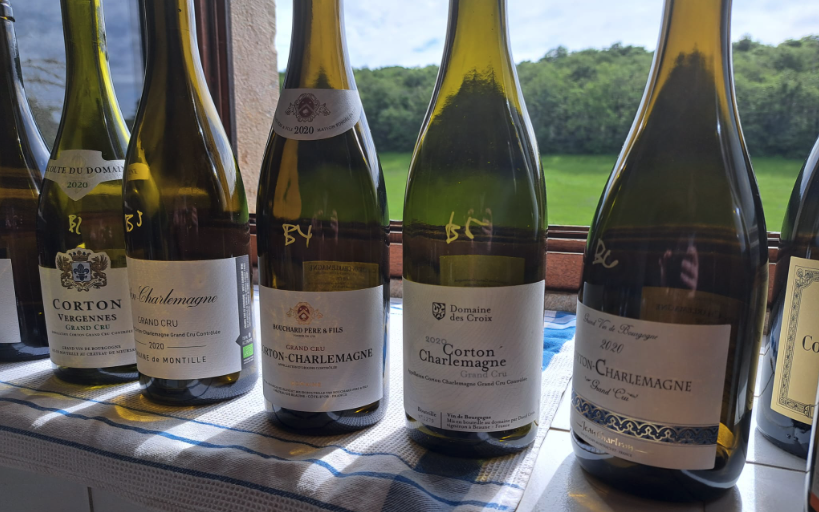
Chablis
As mentioned above, I felt Chablis was one region to shine less brightly in 2020. The heat and drought seemed to impact the exposed, northerly, well-spaced vineyards more than it did the vines of the Cote d’Or. There are good wines but the thrill of austere Chablis that slaps you in the face like a cold and salty ocean wave is getting harder and harder to find in the face of climate change.
Good wines exist – my favourite was the Droin Grand Cru Hommage a Louis and William Fevre also had a good showing – but even my favourite vineyard, Montee de Tonnerre, failed to reach above 93/100.
Meursault
There were some seriously beautiful, seductive wines from Meursault in 2020. I loved the way the floral aspects of the village worked with the white fruit and mineral qualities of the vintage. The crowning glory was a flight of nine 1er Cru Les Perrieres, with at least three of Grand Cru quality, but Les Genevrieres gave it a close run for its money and was a step or two ahead of Charmes in my opinion.
My favourite wines, both with 97/100, were the Meursault 1er Cru Les Perrieres from Domaine Roulot (not due for release until at least 2030) and Vincent Girardin. Other names to look out for include Ballot-Millot, Darviot-Perrin, Antoine Jobard and Alvina Pernot.
Saint Aubin
I was disappointed by our two flights of Saint Aubin. The 1er Cru Les Perrieres from our friend Jean-Michel Chartron was a wine of quiet class and chalky acidity (90/100) but I suspect his Dents de Chien, which we did not taste, would have been several steps ahead. I will open one at home soon!
Overall I found these wines quite middle-of-the-road. Perhaps our expectations of the village have been heightened in recent years but the exposed, hilltop vineyards struggle that much more in warmer, drier conditions? Given Saint Aubin is no longer the bargain it once was, I suspect the wines are judged all the more harshly.
My surprise winner of the flight (93/100) was Domaine Henri Prudhon’s 1er Cru En Remilly.
Chassagne Montrachet
We begin with some of the less prestigious vineyards and finished with top sites such as Blanchots Dessus, abutting Le Montrachet, and Vide Bourse, just below Batard. Chassagne is currently blessed with a concentration of extremely talented and dynamic winemakers – such as Thierry Pillot cited above as one of the stars of the vintage – so there were exciting wines from throughout the village but the structure of our flights definitely gave a crescendo towards the finish.
Jean-Claude Bachelet’s 1er Cru Blanchots Dessus was my most highly-rated wine (97/100) but there were also outstanding examples from Marc Colin, Simon Colin and Darviot-Perrin, alongside the previously mentioned superstar, Paul Pillot.
Puligny Montrachet
A hotbed of top domaines and famous terroirs, Puligny performed true to type at Burgfest and delivered a number of compelling wines. Taken as a whole, I simply gave fewer low scores to the 2020 Pulignys; the average bar of quality was ratcheted up as we tasted through these wines.
I have a massive soft spot for the 1er Cru vineyard of Les Combettes and Leflaive’s version took top honours in my scoring with 97/100.
By contrast, I have a blind spot for Les Pucelles and tend to prefer the more mineral style of Puligny Caillerets. 2020 turned this on its head and the flight of five Pucelles included wines of pitch-perfect poise and finesse. I rated Jean Chartron’s monopole Clos de la Pucelle 95/100 and was delighted to see it come joint top of the flight, for the group, ahead of Domaine Leflaive’s rather more expensive version.
Corton Charlemagne
The reputation of this Grand Cru is rising as producers such as Bizot, Ramonet and Domaine de la Romanee Conti have moved into the vineyard. However, this remains a large and varied appellation. Our tasting demonstrated this variability – my scores ranging from 85/100 to 95/100 – but the average quality in 2020 was undoubtedly higher than in many other years, the wines showing brighter, fresher fruit and greater dynamism.
My 95/100 winner of the flight came from Henri Boillot.
2020 Corton Charlemagne Grand Cru, Henri Boillot
Complexity, fragrance and chalky minerality all amplified. Has a marked stamp of barrel-driven, reductive winemaking but wears it well and has the fruit intensity to sustain it. Saline, lemony fruit – preserved lemons – with a melted butter texture and lovely mid-palate presence. Manages to be very Corton Charlemagne in minerality and structure but also to hold bright and engaging fruit.
95/100 – Matthew Hemming MW
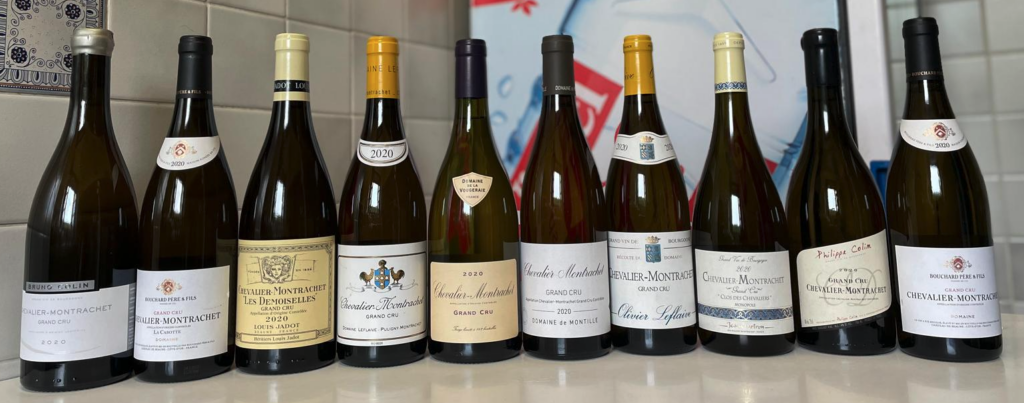
Grand Crus of Puligny and Chassagne
To make my flight home, I had to leave early and forgo the quintet of Montrachets served as Burgfest’s grande finale – I fear this might be a sackable offence. Still, I managed the embarrassment of riches presented by three Bienvenues-Batard Montrachets, seven Batard Montrachets and a full ten(!) Chevalier Montrachets. Suffice to say, this was a tour de force of white Burgundy.
I have already revealed that my pick of the entire Burgfest was Bouchard’s Chevalier Montrachet La Cabotte. To conclude this report, I will just highlight one wine each from the other two Grand Crus I tasted.
2020 Bienvenues-Batard Montrachet Grand Cru, Domaine de la Vougeraie
Leflaive? Successfully takes the positive points of #1 [J-C Bachelet’s BBM], builds upon and amplifies them. Really unfurls gloriously – it doesn’t explode, although there’s masses of spice, so much as languidly stretch itself out on the palate. Very luxurious, with melted butter, grilled nuts and cream. The fruit completely drowns out the winemaking, although there’s great sophistication there. Seamless and spherical. Saline and mineral.
96/100 – Matthew Hemming MW
2020 Chevalier Montrachet Grand Cru, Vincent Girardin
Rides on intensity, mineral cut and vivid, mouth-watering fruit. Citric and floral, with white flower characters and a high tensile structural spine. Very nicely restrained as, here, you can feel the energy straining against the wine’s structure and bursting to get out. This is extremely successful, nervy and exciting.
97/100 – Matthew Hemming MW
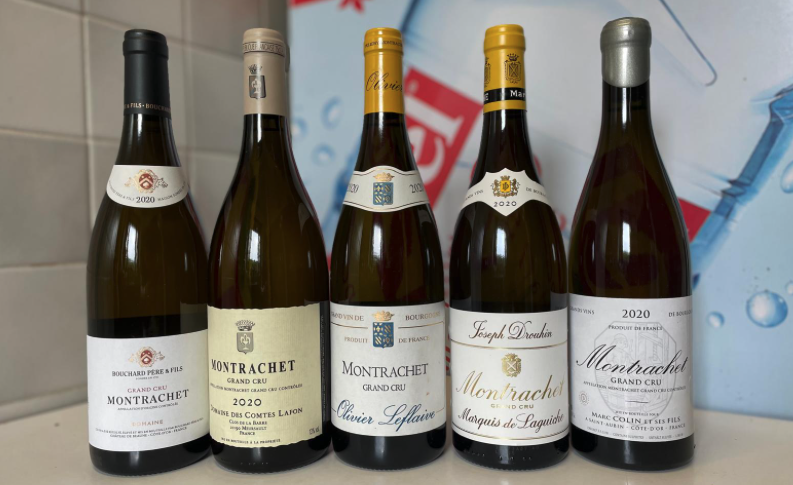
The ones that got away – what a flight to miss!